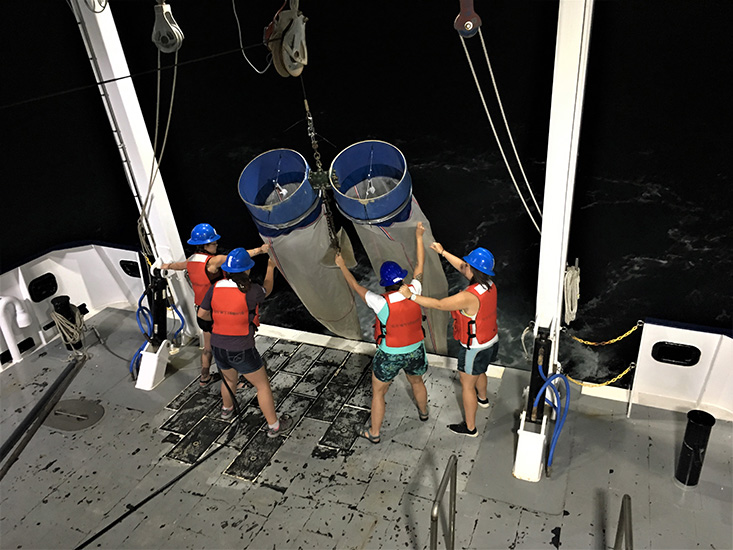Written by Sean Beckwith, PhD student
The briefing included a weather forecast of mostly clear skies and calm seas—not the deciding factor on my decision to confirm participation on the oceanographic cruise to collect fish eggs across the West Florida Shelf (WFS), but a very nice bonus.
This year, 2019, begins a 15-year monitoring program funded by the Florida RESTORE Act Centers of Excellence Program. Dr. Ernst Peebles is principal investigator of the study, Spawning Habitat & Early-Life Linkages to Fisheries (SHELF), along with co-investigators Dr. Mya Breitbart, Dr. Steven Murawski, Dr. Christopher Stallings, Dr. Kevin Boswell (Florida International University), and Dr. James Locascio (Mote Marine Laboratory).
The 11-day cruise was split into two legs, with a day at port for refueling, re-gearing, and switching out members of the scientific party. I took the opportunity to join Leg 1, which returned Sunday, the 11th, after completing the northern half of the WFS sampling path.
Captained by Ryan Healy of the Florida Institute of Oceanography, the R/V Hogarth set sail Tuesday morning (the 6th) for Station 1, located 50 miles west-southwest of the mouth of Tampa Bay. Several hours later we lowered the Bongo plankton nets into the water, towed for 15 minutes and retrieved our first samples – hopefully containing a bonanza of fish eggs.
It’s incredibly challenging to determine where fish actually spawn. Researchers can’t be everywhere all the time, watching the fish spawn. Also, identifying juveniles (and then extrapolating back to where they likely spawned) is controversial because the eggs can float long distances. So, until the recent advent of new techniques (using DNA), identifying fish eggs was tedious to impossible.
Plastic jars screw into the tapered ends of the conical nets to collect the organic material, which will be capped and stored for later analysis in the lab. But first, the nets must be washed down with a seawater hose as the wench operator hoists them onto the back deck of the Hogarth.
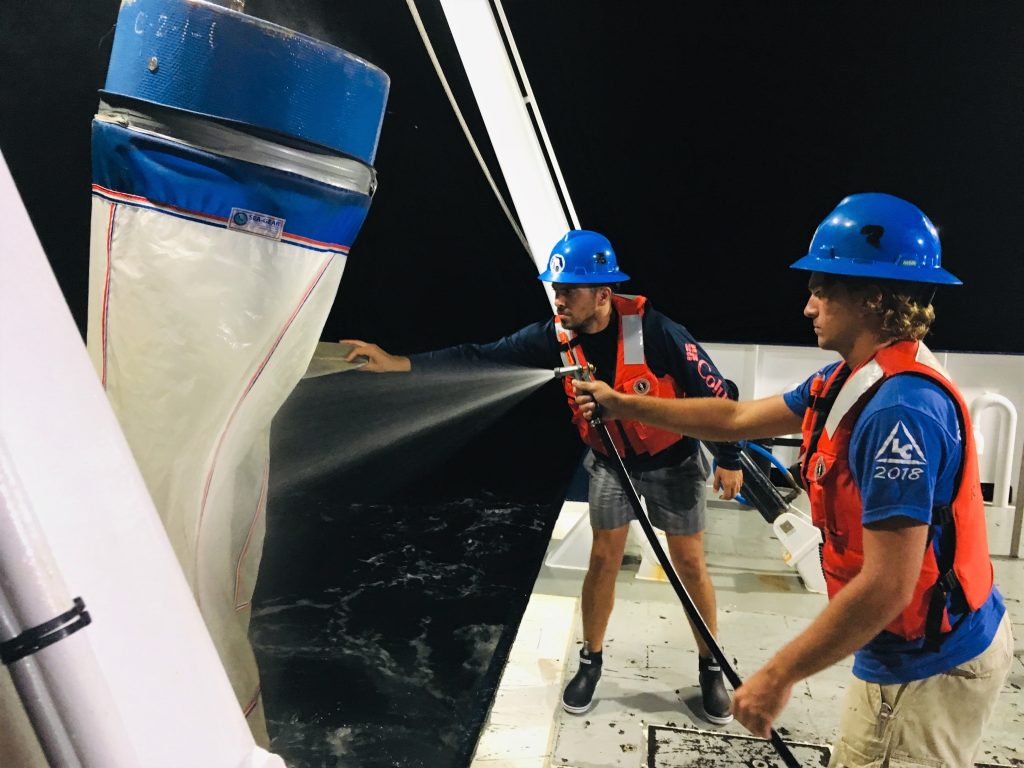
Garrett Miller (foreground) and Ian Williams retrieve and hose down the Bongo nets at the last station on one of their noon to midnight shifts.
Fish eggs are tiny and transparent, so the naked eye cannot be trusted to catch every
egg that might be gripping the insides of the Bongo nets. The nets are systematically
washed from top to bottom to rinse all the eggs – as well as phytoplankton, zooplankton,
jellyfish and anything else that wound up passing through the open mouths of the towed
Bongo nets – into the collection jars. To make space in the one-liter jars for preservatives,
seawater is poured back out of the jars through the sides of the nets and the bio-matter
is carefully ushered back into the jars with the seawater hose. The key is to wind
up with jars that are about 50% full of seawater and organic material so that preservatives
can be added from chemical work stations inside the ship’s scientific lab. Of the
two jars collected with each tow, isopropanol (rubbing alcohol) is added to one, filling
it to 100%, and 50 mL of formaldehyde is added to the other (a 1 to 10 ratio of formaldehyde
to sample).
Fish eggs nearly all look alike – that is, most species spawn eggs that are small and clear, a somewhat daunting and most definitely painstaking challenge for scientists trying to identify them by microscope. A more reliable method is to utilize DNA-barcoding, a process which looks at the soup of genetic material extracted from samples and categorizes it by the specific species of fish present. One limitation, though, is that this method provides presence/absence of various fish species for a given sample location, but it cannot tell you the abundance of eggs for a particular species.
Read more on the methods and on the background for the fish egg DNA-barcoding research.
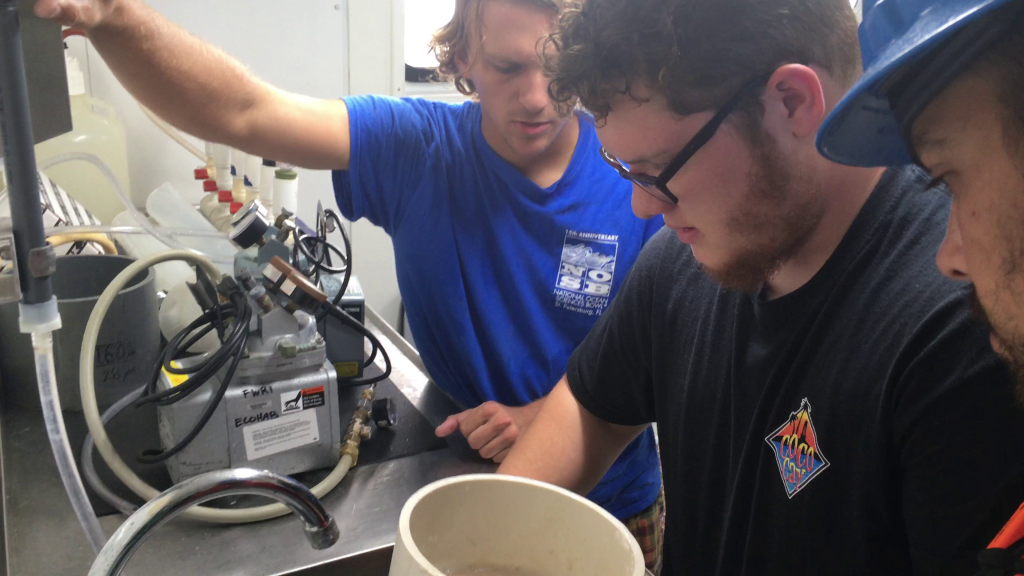
Sebastian DiGeronimo’s main task on the noon to midnight shift was to serve as data recorder. Here he washes the organic matter, including the unseen fish eggs, over a sieve to concentrate the material before adding it to the collection jar. Garrett Miller and Ian Williams look on, ready to assist.
The planned cruise path calls for 68 stations, but weather, boat and gear sometimes
alter plans. Hitting as many of the stations as cruise time allows, the scientific
party returned the samples to the laboratories at CMS for processing. With an array
of sampling locations, the group of researchers hope to understand what species are
spawning where on the WFS. This year’s cruise is in August to target the spawning
period of reef fishes (like snappers), while next year’s cruise will occur in spring
to target grouper spawning.
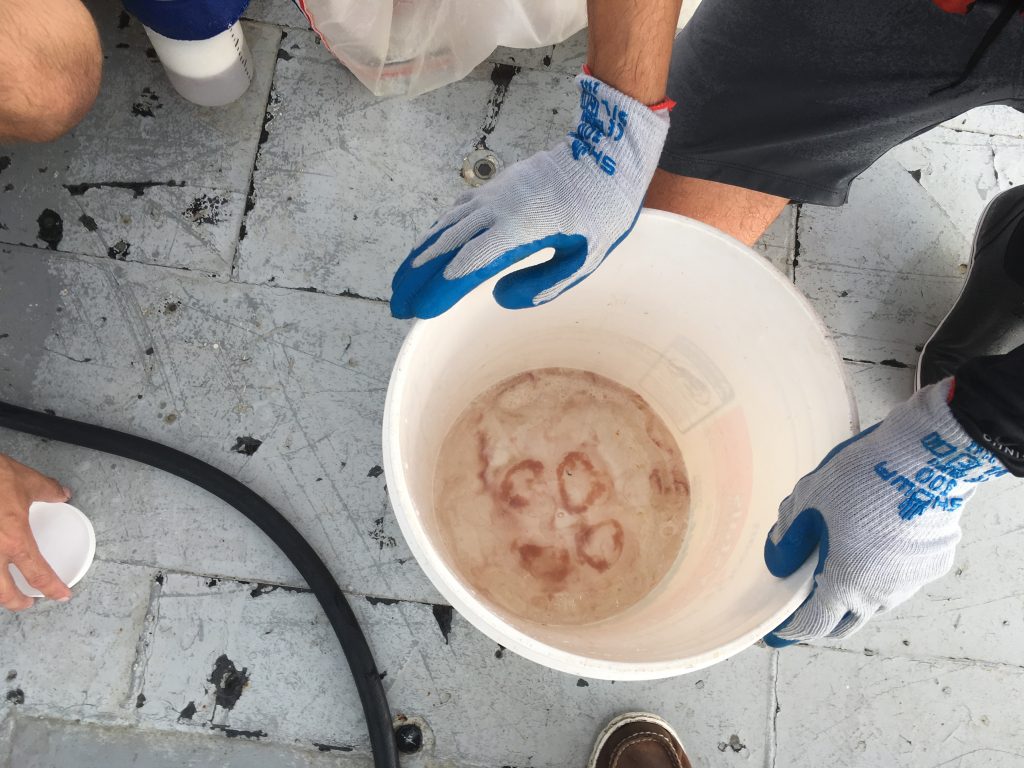
One of the larger jellyfish collected, and scooped out of, the Bongo nets. Large jellies and anything else not added to the collection jars must be rinsed on top of a sieve to retain any potentially present fish eggs, which are too small and clear to be seen by the naked eye.
On Leg 1, the coastal sampling stations brought us close enough to see beaches, trees,
and buildings at some of the Panhandle locations, like Pensacola and Cape San Blas
(near Apalachicola). The scientific crew worked day and night, splitting into two
12-hour shifts starting at noon and midnight. While each shift saw their fair share
of jellies collected in the Bongo nets, the night shift definitely saw more dolphin
action.
During some of the late-night net tows, Atlantic spotted dolphins shot across the surface of the water, chasing flying fish that broke from their school and took flight. Standing on the bow at the start of one of the night shifts, I had the privilege of watching a pod of dolphins surf the bow waves for nearly an hour as I talked with a fellow cruise participant. It was remarkable to see how easily they could manage the waves and maintain their position; even the calves kept in perfect unison with their mothers.
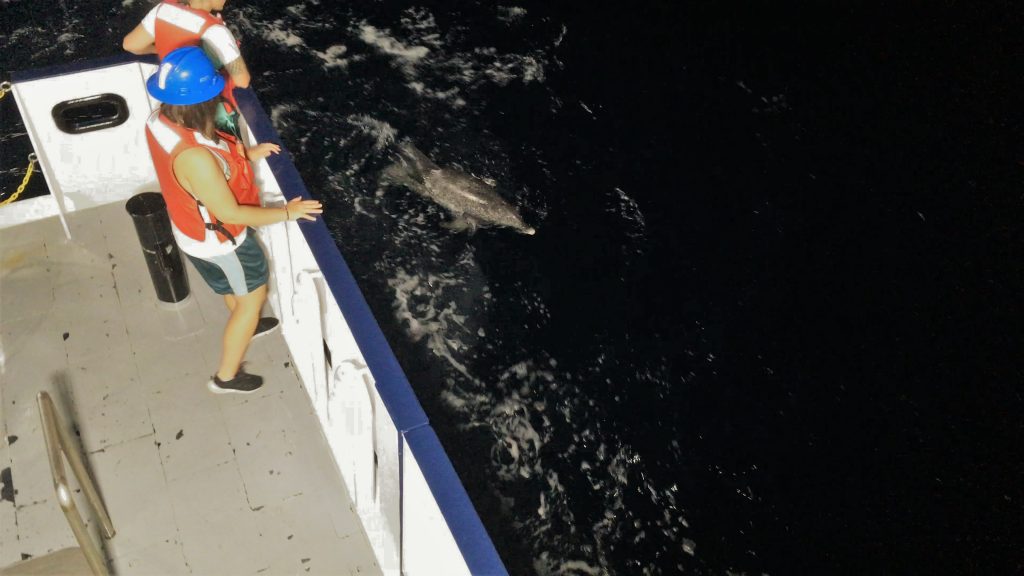
An Atlantic spotted dolphin surfacing along the port quarter of the R/V Hogarth.
Although the focus of the cruise was on microscopic fish eggs (not dolphins), one
deep water station was added to the cruise plan to allow for a CTD cast to measure
salinity and temperature at various depths, as well as retrieve water samples.
Brianna Michaud, a Ph.D. candidate and student of Peebles, is chief scientist for this year’s sampling cruise. One particular stretch of sampling stations in the cruise path crosses over Desoto Canyon, a 900-meter deep submarine valley that works its way from the coastal waters off of Pensacola out into the depths of the Gulf of Mexico. Michaud chose one spot along this transect to perform two CTD casts, collecting water at 700, 400, 200, 40 meters, and at the surface. She hopes the water samples will tell us how naturally occurring chemicals change with depth and how those chemicals can be used to trace the transfer of nutrients through the food web. A form of recycling appears to be occurring in the vertical direction, and Michaud will use measurements of the naturally occurring chemicals (stable isotopes) to see how vertically migrating species (like the lantern fish seen in a sample from the same area) may be transferring nutrients from the depths back up to the surface.
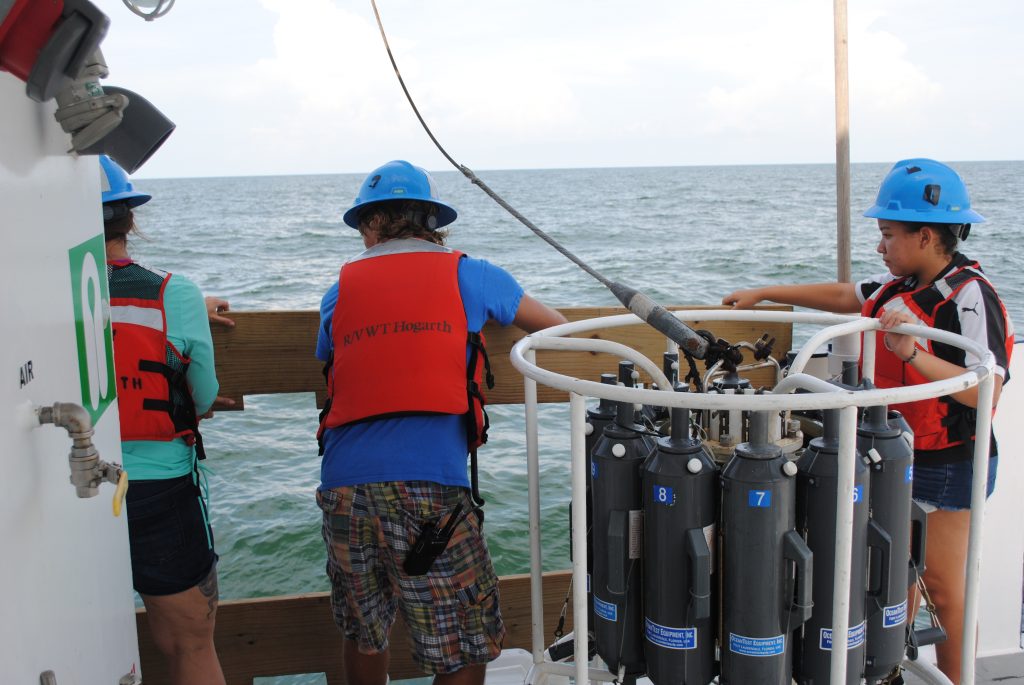
In addition to her primary role of data recorder on the midnight to noon shift, Andrea Rodriguez Campos (holding the CTD rosette) is shown here assisting with a CTD cast over the Desoto Canyon.
Joining Michaud to round out the scientific party on Leg 1 were fellow students from
the College of Marine Science, Garrett Miller and Ian Williams; from the USFSP program
for Environmental Science and Policy, Geography and Sustainability, Sebastian DiGeronimo, Abby Blackburn and Andrea Rodriguez Campos; from the USF Tampa
program for Environmental Science and Policy, Nicole Seiden; and from Eckerd College, Grace Koziol. And, none of this would have been possible without the crew of R/V Hogarth, keeping everything in working order, on course, and serving up tasty meals three
times a day.
With the new DNA-barcoding method, the 15-year monitoring survey will provide a much more robust picture of where the fish are spawning, which has powerful implications for the sustainability of Gulf fisheries. After the lab work and data crunching wraps up, I look forward to hearing the results of samples collected on both cruise legs.
